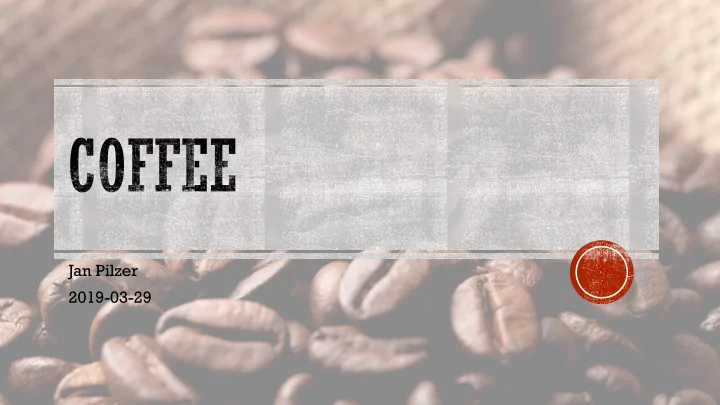

Jan Pilzer 2019-03-29
▪ From Bean to Cup: a history of coffee Michael Firmin, 19 Sep 2014 ▪ Coffee Shops Around Vancouver Michael Firmin, 13 Sep 2013 ▪ ABCs of Brewing Coffee Alexandru Totolici, 5 Oct 2012 ▪ Coffee Vs. Chocolate Battle Royale: War of the Chemical Stimulants Mihir Nanavati & Nathan Taylor, 16 Mar 2012 ▪ Coffee Tom Hazelton, 19 Mar 2010 2
Jan Pilzer 2019-03-29
5
6
7
Coffea arabica Coffea canephora ▪ Commonly known as robusta ▪ Originated it Ethiopia ▪ Indigenous to Western Africa ▪ Ideally cultivated at about 1400m ▪ Mostly grown in Vietnam and Africa altitude ▪ Easier to grow than Arabica, therefore cheaper ▪ 60% of the world’s production ▪ Stronger flavor, but more bitterness 8
▪ Abul Hasan ash-Shadhili, an Islamic Scholar (~1200) ▪ Observed birds of unusual vitality in Ethiopia ▪ Ate the same berries and experienced the same vitality ▪ Islamic World ▪ Coffee as replacement for the forbidden wine ▪ Helps fast during the day and stay awake at night ▪ Kaldi, Ethiopian goat-herder (~800) ▪ Noticed the energizing effect of the berries on his goats ▪ When presented to the local monastery, the monks disapproved and threw them in the fire ▪ The smell led them to rescue the beans and make a drink 10
▪ Yemen's Sufi monasteries (~15 th century) ▪ Used for concentration ▪ Spread north to the large cities of Cairo, Damascus, and Constantinople ▪ Forbidden in 1511 by conservative imams in Mecca ▪ Ban overturned in 1524 by order of the Ottoman Sultan ▪ Introduced to Europe through Malta (~16 th century) ▪ Prepared by Turkish slaves ▪ Introduced to Vienna after the Battle of Vienna (1683) ▪ Using supplies from the defeated Turks 11
▪ Brought to the Caribbean as seedlings in 1720 ▪ Starting mass-cultivation in the South-American colonies ▪ Surge in popularity after the Boston Tea Party 1773 ▪ More patriotic than drinking tea ▪ Brazil as largest coffee producer since 1852 ▪ Modern trends ▪ Fair Trade: Increased prices to increase farmers’ share ▪ Sugary coffee drinks can use cheaper beans 12
Wet Process (washed) Dry Process (unwashed) ▪ Sorted by immersion in water ▪ Traditional method ▪ Ripe fruit sinks, unripe floats ▪ Dirt, soil, leaves removed with a large sieve in a process called winnowing ▪ Fruit is stripped from the seed ▪ Remaining pulp removed by ▪ Unripe cherries removed by hand fermentation ▪ Sun dried ▪ Sun or machine dried 14
▪ Remove remaining layers of dry skin ▪ Clean the beans ▪ Sorting by size and density ▪ Removing discolored or defective beans ▪ Separating by color 15
▪ Invented by German merchant Ludwig Roselius (1903) ▪ Steaming the coffee beans ▪ Using benzene as solvent to remove caffeine ▪ Later other solvents (for example ethyl acetate) ▪ Swiss Water Method (1933 / 19800) ▪ Create Green Coffee Extract (GCE) out of beans ▪ Mix CGE with beans to migrate caffeine ▪ Use carbon absorbers to extract caffeine from CGE ▪ In testing decaf can contain about 10mg of caffeine (compared to ~200mg of regular coffee) 16
▪ Roasting at around 175 °C ▪ Weight loss of about 15% ▪ Double the size ▪ Home roasting ▪ Can be done in a pan or wok ▪ Common until the early 20 th century 17
▪ Invented 1881 in France ▪ Invented 1890 in New Zealand ▪ Advanced process by Nescafé 1938 ▪ Brewed with very hot water ▪ Concentrated by evaporation ▪ Freeze drying to remove water ▪ Frozen and broken into small pieces ▪ Warmed in a vacuum chamber ▪ Water removed by condensation ▪ Half the caffeine content 19
▪ Burr-grinding ▪ Beans are crushed or “torn” ▪ Multiple size settings ▪ Good for most brewing ▪ Chopping ▪ Similar to a blender ▪ Cheaper than burr-grinder ▪ Non-uniform results ▪ Pounding ▪ Finest result ▪ Required for Arabic or Turkish coffee
▪ French Press ▪ Also coffee plunger ▪ Patented by Italian designer in 1929 ▪ Cold Brew for Ice Coffee ▪ Cold water ▪ Steeping for 12 to 24 hours ▪ Diluted with water before serving
▪ Paper Coffee Filter ▪ Automatic Drip ▪ Vietnamese Filter ▪ Invented 1908 by German ▪ Wigomat as first electric drip ▪ Metal filter housewife Melitta Bentz coffee maker ▪ On condensed milk with ▪ Clear, light-bodied coffee ▪ Patented 1954 in Germany ice
▪ Espresso Machine ▪ Very hot water ▪ High pressure ▪ First patented 1884 Improved 1905 ▪ Aeropress ▪ Invented 2005 ▪ Coffee is steeped for a few seconds, then forced through a filter ▪ Moka Pot ▪ Boiling water to create pressure ▪ Water forced upwards through coffee
Info Graphic by PopChart https://popchart.co/products/the-compendious-coffee-chart
Recommend
More recommend